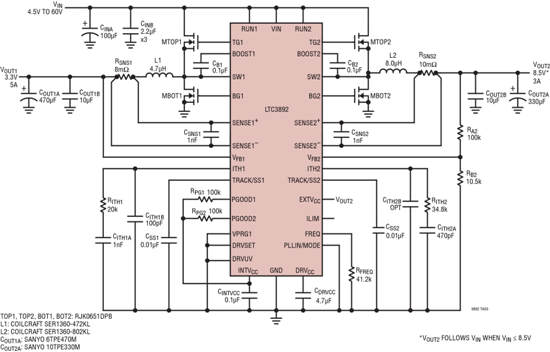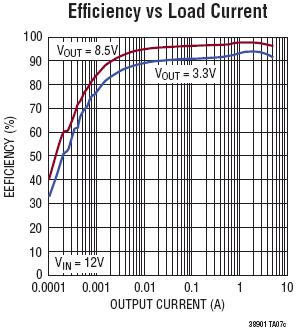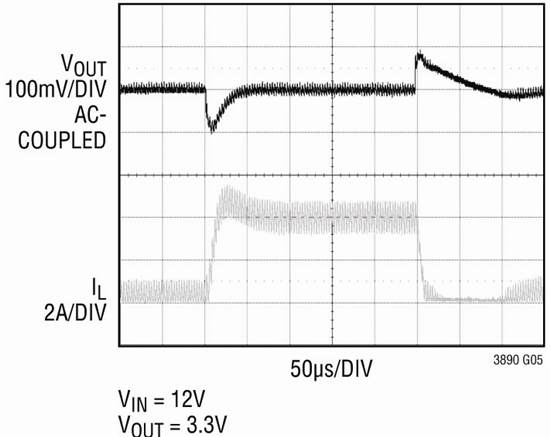Truck, automotive and heavy equipment environments are very demanding for any type of power conversion device. The wide operating voltage range combined with large transients and wide temperature variations all make reliable electronic system design very challenging. To complicate matters that must be considered during design, some applications require that the power conversion device be mounted within the hood, thus requiring high temperature ratings. At the same time, as the number of electronic components continues to increase, so does the available space, making high-efficiency conversions critical due to space constraints.
This article refers to the address: http://
Therefore, reliable truck DC/DC switching regulators need to operate over a wide range of input voltages. The 60V input rating provides a good margin for nominal 12V systems, which are typically clamped in the 36V to 40V range. Dual battery applications common in truck and heavy equipment environments require even higher operating voltages because their battery voltage is nominally 24V. Most of these equipment environments are clamped to 58V, so a 60V rating is usually sufficient. Trucks and cars require built-in overvoltage clamps to limit the maximum transient voltage caused by the inductive kickback voltage of the starter motor, which can result in much higher transient voltages if not clamped.
There are several electronic systems that require continuous power supply even when the vehicle's motor is stopped, such as remote keyless entry, GPS, and security systems. For this type of “always on†system, it is important to use a DC/DC converter with low quiescent current because it maximizes battery run time in sleep mode. In this type of environment, the regulator operates in a normal continuous switching mode until the output current drops below a predetermined threshold of approximately 30 mA to 50 mA. Below this threshold, the switching regulator must enter a lower quiescent current mode of operation to reduce the current drawn to tens of microamps, thereby reducing the power drawn from the battery, which in turn extends battery operation. time.
When the 60V input, high step-down ratio DC/DC converter is in short supply, the designer resorts to a transformer-based topology or an external high-side driver to operate up to 60V. Still others use intermediate bus converters, so additional power stages are required. Both of these methods add complexity to the design and, in most cases, reduce overall efficiency. However, Linear Technology's family of 60V input step-down switching regulator controllers continues to expand, and the LTC3892 is the latest in the family, which addresses many of the key issues in these truck and automotive applications. Figure 1 shows the LTC3892 used in an application that converts 4.5V to 60V inputs to 3.5V/5A and 8.5V/3A outputs.

Figure 1: LTC3892 schematic with 4.5V to 60V input conversion to 8.5V/3A and 3.3V/5A outputs
The LTC3892 / LTC3892-1 is a high voltage, dual output synchronous step-down DC/DC controller that draws only 29μA when one output is active and draws 34μA when both outputs are enabled. The 4.5V to 60V input supply voltage range is designed to protect against high voltage transients, ensuring continuous operation when the car is cold and has a load dump, and is suitable for a variety of input power and battery chemistries. With an output current of more than 20A and an efficiency of up to 96%, each output can be set between 0.8V and 99% VIN, making the device ideal for 12V or 24V truck, automotive, and heavy equipment applications.
The LTC3892 / LTC3892-1 operates from an optional fixed frequency of 50kHz to 900kHz and can be synchronized to an external clock from 75kHz to 850kHz. At light loads, the user has the option of working in continuous operation, pulse skipping and low ripple burst mode (Burst Mode®). The two-phase operation of the LTC3892 / LTC3892-1 reduces input filtering and capacitance requirements. Its current mode architecture provides very easy loop compensation, fast transient response, fixed frequency operation, excellent voltage regulation, and allows current sharing to be easily achieved with parallel phase. Output current sensing is accomplished by measuring the voltage drop across the output inductor (DCR) for maximum efficiency or by using an optional sense resistor for high accuracy.
The LTC3892 is a full-featured version, unlike the LTC3892-1. The LTC3892 provides two power good signals, an adjustable current threshold, and a fixed 3.3V or 5V output voltage option. The LTC3892 is available in a 5mm x 5mm QFN-32 package and the LTC3892-1 is available in a TSSOP-28 package. Available in four temperature grade versions, extended and industrial temperature grades operate from –40°C to 125°C, high temperature automotive grades from –40°C to 150°C, and military grades –55 Operation in the temperature range from °C to 150 °C is guaranteed.
Burst mode work
Under low load current conditions, the LTC3892 / LTC3892-1 can be enabled to enter high efficiency Burst Mode operation, constant frequency pulse skipping, or forced continuous conduction mode. When configured to perform burst mode operation and under some light load condition, the converter will suddenly emit a small amount of pulses to maintain the charging voltage on the output capacitor. It then turns off the converter and goes into sleep mode, when most of its internal circuitry is turned off. The output capacitor is responsible for providing the load current. When the voltage across the output capacitor drops to a set level, the converter re-runs and provides more current to supplement the charge voltage. The ability to turn off and turn off most of its internal circuitry greatly reduces quiescent current, helping to extend battery run time in systems that remain on when the system is not operating. Figure 2 shows a conceptual timing diagram illustrating how it works.

Figure 2: Voltage diagram for LTC3892 / LTC3892-1 Burst Mode operation
Burst mode output ripple is unaffected by the load, so only the length of the sleep interval will vary. In sleep mode, most of the internal circuitry is turned off, except for critical circuits that require fast response, further reducing quiescent current. When the output voltage drops low enough, the sleep signal goes low and the controller resumes normal burst mode operation by turning on the top external MOSFET. In addition, there are some cases where the user wishes to operate in a forced continuous or constant frequency pulse skip mode at light load currents. Both modes are very easy to configure, but have large quiescent current and low peak-to-peak output ripple.
In addition, the inductor current is allowed to reverse at light loads or in large transient conditions when forced continuous mode of operation or clocked by an external clock source. The advantage of continuous operation is that the output voltage ripple is low, but produces a large quiescent current.
Characteristics
Each channel has an overvoltage comparator to protect against transient overshoots and other more severe conditions that may cause output overvoltages. When the VFB1, 2 pins rise above 10% above their 0.800V stable point, the top MOSFET turns off and the bottom MOSFET turns on until the overvoltage condition is cleared. Fast, accurate overcurrent limit protection is essential in high voltage power supplies. When the output voltage drops below its nominal value of 70%, the foldback current limit is initiated, gradually reducing the peak current limit in proportion to the severity of the overcurrent or short circuit condition.
MOSFET driver and efficiency
The LTC3892 / LTC3892-1 has a powerful 1.1Ω internal N-channel MOSFET gate driver to minimize conversion time and switching losses. The gate drive voltage can be set from 5V to 10V to allow logic or standard level N-channel MOSFETs to be used to maximize efficiency. Since a large drive current is available, multiple MOSFETs can be driven in parallel for larger current applications.
The LTC3892 efficiency curve in Figure 3 is a typical efficiency curve for the schematic of Figure 1 with a 12V input voltage. As shown, the 8.5V output produces a very high efficiency of 98%. The efficiency is also over 90% at 3.3V. In addition, this design still exceeds 75% efficiency at each output with a 1mA load. The reason for the high efficiency is the use of burst mode work.

Figure 3: Efficiency curve of the LTC3892 at 12V input, 8.5V and 3.3V output
Fast transient response
The LTC3892 implements voltage feedback using an amplifier that operates at a fast 25MHz bandwidth. The amplifier's large bandwidth plus high switching frequency and low inductance value allows for very high crossover frequencies. This allows the compensation network to be optimized for very fast load transient response. Figure 4 illustrates the transient response of a 4A step load at 3.3V output, deviating from the nominal value by less than 100mV.

Figure 4: Transient response curve of the LTC3892 shown in Figure 1 at 3.3VOUT/12VIN
in conclusion
The LTC3892 / LTC3892-1 brings new levels of performance for safe and efficient operation in demanding high voltage transient environments. The powerful adjustable gate drive voltage provides the flexibility to drive logic or standard level MOSFETs. Its low quiescent current saves battery power during sleep mode, which extends battery run time, a very useful feature in bus systems that are always on. The 60V maximum input voltage, fast transient response and high temperature version make the LTC3892 / LTC3892-1 an excellent choice for trucks, heavy equipment and automotive applications. As a result, system designers now have the best choice for their DC/DC conversion needs.
Navigating Digital Clarity with HD Screen Protectors
As digital integration deepens, the demand for pristine screens on our devices has never been more evident. High-Definition Screen Protectors stand as stalwarts against damage, ensuring our interactive windows to the world remain unblemished and vivid.
The Essential Shield: HD Screen Protector
An HD Clear Screen Protector is an essential tool against the onslaught of daily threats our devices face. These guardians fight off the common culprits of screen damage-keys, drops, and the continuous contact of our fingertips-while ensuring the display's integrity.
Enhanced Visibility with High-Definition Screen Protectors
Beyond safeguarding against physical damage, High-Definition Screen Protectors play a pivotal role in enriching our visual interaction. They are the unsung heroes that maintain the dynamic range of colors and detail necessary for an optimal viewing experience, whether gaming, leafing through photos, or streaming.
Clarity Preserved: Fusing Protection with Transparency
With the goal of delivering clear protection, HD Screen Protectors are crafted to be Transparent Screen Films, upholding the screen's original luminosity and detail. Their near-invisible presence coupled with their protective properties results in a shield that doesn't distract from the beauty of the screen but rather enhances it.
Touch Sensitivity Untouched: HD Clear Screen Protector
The HD Clear Screen Protector is also keenly designed to maintain touch sensitivity. Every interaction, from navigating menus to executing gestures, is as intuitive and responsive as it would be on an unprotected screen, ensuring the digital experience remains fluid and natural.
Tough Yet Invisible: Transparent Screen Film
Not just a clear overlay, Transparent Screen Film is a synonym for toughness, ready to tackle the sharp edges and rough surfaces that threaten your screen's pristine condition.
Finding Your Ideal HD Screen Protector
In choosing your HD Screen Protector, consider these factors to guarantee you get a product that fits not just your device, but your lifestyle as well:
Device Specificity: Match the protector with your device for exact coverage and uncompromised aesthetics.Material Matters: Match your needs with the right materials-whether it's the classic tempered glass or a modern TPU variant, find the balance between protection and clarity that works for you.Embodying Screen Perfection
The integration of an HD Screen Protector into your digital ecosystem equates to embracing both clarity and resilience. From a variety of choices, an HD Screen Protector stands out as a straightforward, reliable selection for those who prioritize seamless functionality along with crystal-clear display quality. Transform your device's resilience and retain the joy of a luminous, crisp screen by choosing the right High-Definition Screen Protector.
Hd Screen Protector,High-Definition Screen Protector,Hd Clear Screen Protector,Transparent Screen Film
Shenzhen TUOLI Electronic Technology Co., Ltd. , https://www.szhydrogelprotector.com